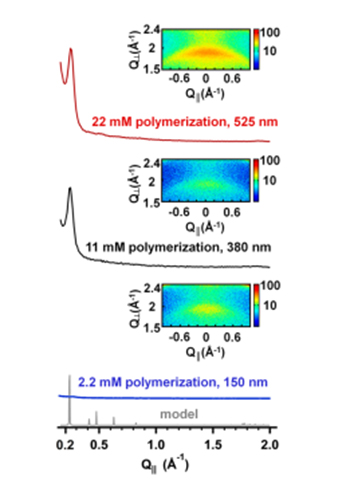X-RAY RUNS: Apply for Beamtime
2017 Nov 1 - Dec 21
2018 Feb 7 - Apr 3
2018 Proposal/BTR deadline: 12/1/17
2018 Apr 11 - Jun 4
2018 Proposal/BTR deadline: 2/1/18
The Dichtel lab at Cornell University focuses on covalent organic frameworks (COFs). When subunits of the self-organized COFs are able to react electrochemically, one could envision developing an energy storage device based on molecularly engineered active materials. In previous work in the Dichtel lab from Catherine DeBlase and coworkers, this principle was demonstrated using anthraquinone subunits. However, the electroactive COFs were not oriented. DeBlase found that by slowly introducing the monomer concentration, the COF film thickness can be controlled. Crystalline, oriented thin films were grown on gold working electrodes and analyzed using grazing incidence diffraction (GID) at CHESS’s G2 beamline. The oriented films had 400% improved capacitance compared to that of randomly oriented COF powder.

The above figure shows one-dimensional projections at low values of Qǁ of the GIDs obtained for DAAQ-TFP COF films show diffraction peaks when grown at higher monomer concentrations (22 mM, red, or 11 mM, black). Films grown under more dilute conditions (2.2 mM, blue) do not show in-plane diffraction peaks. Insets: Diffraction associated with the out-of-plane (001) stacking peak for the 22, 11, and 2.2 mM polymerizations, respectively, indicates that each film forms an oriented, layered structure.
Details of this research can be found in:
Catherine R. DeBlase, Kenneth Hernàndez-Burgos, Katharine E. Silberstein, Gabriel G. Rodríguez-Calero, Ryan P. Bisbey, Héctor D. Abruña, and William R. Dichtel, "Rapid and Efficient Redox Processes within 2D Covalent Organic Framework Thin Films," ACS Nano 2015 9, 3178-3183. DOI: 10.1021/acsnano.5b00184.
Submitted by: Katharine Silberstein, CHESS, Cornell University
01/12/2016
